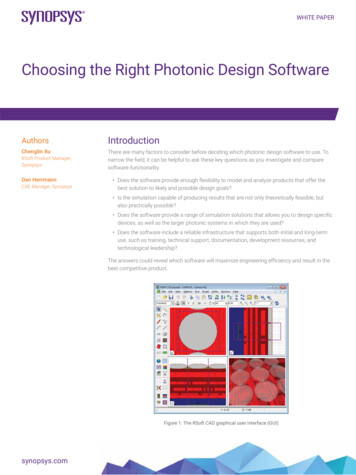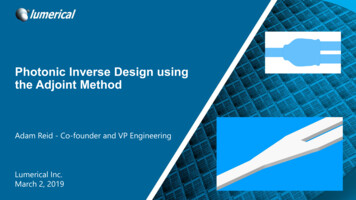
Transcription
WHITE PAPERChoosing the Right Photonic Design SoftwareAuthorsIntroductionChenglin XuThere are many factors to consider before deciding which photonic design software to use. Tonarrow the field, it can be helpful to ask these key questions as you investigate and comparesoftware functionality.RSoft Product Manager,SynopsysDan HerrmannCAE Manager, Synopsys Does the software provide enough flexibility to model and analyze products that offer thebest solution to likely and possible design goals? Is the simulation capable of producing results that are not only theoretically feasible, butalso practically possible? Does the software provide a range of simulation solutions that allows you to design specificdevices, as well as the larger photonic systems in which they are used? Does the software include a reliable infrastructure that supports both initial and long-termuse, such as training, technical support, documentation, development resources, andtechnological leadership?The answers could reveal which software will maximize engineering efficiency and result in thebest competitive product.Figure 1: The RSoft CAD graphical user interface (GUI)synopsys.com
Modeling and AnalysisPhotonics systems are rapidly evolving. Technical requirements and technical approaches for these systems are increasing incomplexity and performance to such an extent that the limiting factor on the final product may be the capabilities of the photonicdesign software. Therefore, choosing a software product that supports the largest array of modeling and simulation features is thebest way to ensure that your photonic products are differentiated in the market.The first step for any design is modeling the system geometry. Given a design tool with maximum flexibility, a designer canexperiment with multiple design forms to meet a design specification or goal; the more configurations you’re able to consider,the more likely you are to achieve an optimal solution.It’s essential to have a design environment that can be used to draw both simple and arbitrary geometries. The RSoft CADenvironment is fully parametric: any parameter can be expressed as a user-defined symbol that can be defined as an arithmeticfunction of any other parameter. In this way, complicated designs can easily be created and parameter scans can easily be used todetermine optimal device performance.Another modeling challenge you might encounter is including fabrication defects. Although it is useful to simulate ideal structures,the reality is that no device can be perfectly fabricated. RSoft provides the tools needed to study the effects of misalignment,fabrication defects such as sidewall roughness, and other manufacturing defects to ensure device performance. While these mayseem like straightforward capabilities, they are not universally found in photonic design products.Photonic design software should also be able to simulate a wide variety of system types. One type of system that can be difficult tosimulate is photonic crystals. RSoft’s Plane Wave Expansion (PWE) algorithm accurately models these devices. Without PWE, it canbe impossible to fine-tune the bandgap of photonic crystals. While other methods such as Finite-Difference Time-Domain (FDTD) canbe used, they can be inefficient and far from optimal.Transverse index profileE x mode profile (neff (0.9979848, 010X(µm)2030Figure 2: a) Converted index profile of a photonic crystal fiber (PCF) cross-section that shows geometry variations introduced during fabrication,and b) Calculated modes of exact PCF fiber found with FemSIMSimulation EfficiencyOne of the biggest challenges of designing photonic systems is the amount of time required to perform the simulation. In practice,a simulation can take hours, days, or even weeks. Furthermore, there are many systems that could take months or years to simulate,which makes them impractical for designers to attempt. Selecting design software that can not only theoretically design your system,but can also do so in a practical, efficient timeframe, can be the most important criteria when choosing software for designingphotonic components.2
The Finite Difference Time Domain (FDTD) algorithm directly solves Maxwell’s equations, but does so in a “brute force” manner that iscomputationally extremely demanding. Because of the flexibility of the FDTD method to design any system, selecting software witha robust FDTD implementation should be a key decision criteria, particularly if your design goals do not meet criteria supported byone of the much more efficient and practical algorithms. If your design goals do not require an FDTD solution, then you should ensurethat your software supports other approaches like the Beam Propagation Method (BPM), Plane Wave Expansion (PWE) algorithm,Rigorous Coupled Wave Analysis (RCWA), or the Coupled Wave Mode Theory (CMT) algorithm.There are many examples of systems or device geometries that are not feasible using FDTD software. Large ( 10 wavelength) waveguide-based devices such as couplers, splitters, DWDM, and mode converters can easily bemodeled with BPM many orders of magnitude faster than FDTD. The BPM method, for applicable problems, is almost universallyfaster than FDTD. Consider the star coupler of a Si-based AWG (Arrayed Waveguide Grating): a 3D BPM simulation of such adevice is at least 100 times faster than 3D FDTD. So-called 2.5D FDTD methods may work in some limited cases, but not for allstructure types The band structures of photonic crystals are more efficiently modeled with PWE than FDTD. PWE solves for the eigenstatesof a photonic crystal in the frequency domain directly, which gives faster and more accurate results when compared to timedomain based FDTD Periodic surface gratings can easily be modeled by RCWA. For many structures, the RCWA method is faster than FDTD. Considera simple Si-based checkerboard grating: a 3D RCWA simulation of this device will be at least 50 times faster than 3D FDTD Periodic structures like fiber-Bragg gratings can quickly and efficiently be modeled with CMT. It is not possible to use FDTD forthese structuresHybrid band map for Y-parity even modesFrequency (ωa/2πc a/λ)0.360.340.320.300.280.260.240.360.380.400.42 0.44 0.46Normalized K z0.480.50Figure 3: a) AWG device, b) Defect mode of a PBG, and c) Checkerboard structureThere are some devices that require an FDTD-based solution. Selecting software that maximizes practical usage of the FDTDsoftware is critical. For example, the software should ensure that the best computational techniques are fully employed tominimize the required simulation time. For instance, RSoft products fully support multicore CPU clustering, optimal index averaging(sometimes called conformal meshing), and non-uniform grids to help make FDTD simulations practical in many cases where theywould not otherwise be. In addition, features such as dynamic field display during simulation (useful when first working on a design)and the ability to run multiple, simultaneous simulations are very useful.Broad Range of Photonic SimulationsThe first step in designing a photonic device might be drawing the overall system, designing a groundbreaking active device thatthe system will leverage for competitive advantage, or designing a series of photonic devices that will work together in a largersystem. This first step and each design step that follows should be factored into the decision about which photonic design softwareis the best to use for your project. The most efficient approach for minimizing time to market for the final product dictates usingdesign software that supports both passive and active photonic devices and supports simulation of the system in which all thesedevices will operate.3
RSoft products offer many tools for designing both passive and active photonic devices, as well as system design tools. The passivedesign tools support the design of a broad range of devices, including waveguides, fibers, gratings, sensors, and LEDs. Active designtools allow you to model and simulate devices such as modulators, semiconductor lasers (FP, DFB, and VCSEL), detectors, and solarcells. All these devices can be combined with other devices in a system-level simulation to determine system performance. Thisrange of photonic simulation capabilities, unique to the RSoft products, can be a compelling reason for selecting a software designtool. In addition, RSoft products support common interchange formats with CODE V and LightTools optical design software toextend the modeling capabilities to a wide range of illumination and imaging applications.Reliable InfrastructureThe strength and range of photonic software capabilities are relevant only to the degree that any given user or company is able toleverage those capabilities. Important tools that help ensure productive usage of a software tool include documentation, training,examples, and technical support.Documentation, training, and application examples help users understand how to use the software, as well as the software’s benefits,strengths, and the limitations of design approaches or algorithms. Without an in-depth understanding of the algorithms, users canunknowingly end up with wrong results. Clear and detailed documentation can help prevent this from occurring. Technical supportstaff, trained in photonics engineering and knowledgeable about the software, can help overcome specific issues that arise in agiven design as well as help users head in the right direction at the beginning of project, thereby maximizing efficiency and thelikelihood of success.With more than 40 years of combined photonics experience, RSoft’s team of technical support staff has published numerous, over250 technical papers and has contributed to the development of the simulation algorithms (BPM). The staff has a close workingrelationship with the RSoft development team, which allows the product developers to be directly involved with customer issueswhenever necessary. Customer success is the overriding objective of the RSoft team, and it determines staff priorities and objectives.In addition to the support infrastructure for the current product, it is critical to have a developer-vendor that can be counted on inthe future. The criteria for this includes a capable, committed development team, resources for future investment and development,and a range of photonic and algorithmic backgrounds among the technical staff to ensure that future innovation opportunities areaddressed by the software. RSoft products are a part of the Optical Solutions Group at Synopsys, which includes CODE V, LightTools,and LucidShape . There is much synergy between these products, as well as the broader Synopsys products.Synopsys, Inc. provides products and services that accelerate innovation in the global electronics market. As a leader in electronicdesign automation (EDA) and semiconductor intellectual property (IP), Synopsys’ comprehensive, integrated portfolio of system-level,IP, implementation, verification, manufacturing, optical and field-programmable gate array (FPGA) solutions help address the keychallenges designers face such as power and yield management, system-to-silicon verification and time-to-results.These technology-leading solutions help give Synopsys customers the competitive edge needed to quickly bring the best products tomarket while reducing costs and schedule risk.For more than 25 years, Synopsys has been at the heart of accelerating electronics innovation, with engineers around the worldhaving used Synopsys technology to successfully design and create billions of chips and systems found in the electronics thatpeople rely on every day. Today’s designers face tremendous pressure to develop differentiated products more quickly and costeffectively than ever before. At Synopsys, helping companies accelerate innovation is in our DNA.Integrated Solutions to Accelerate Optical Systems InnovationIn addition to the RSoft products, Synopsys’ industry-leading optical design solutions include CODE V for imaging optics design,LightTools for illumination design, and LucidShape for automotive lighting design. Together, these products provide a full spectrumof photonic and optical design solutions.4
SummaryThe decision about which photonic design software to invest in should not be taken lightly. The quality of new products is oftenincumbent upon the capabilities of the design tool, which can either encourage innovation or limit it. There are many practicaltechnical issues that can maximize the success of photonic design software at a given company, and some of these have beenoutlined above. The decision should not be based on a cursory technical specification or a single feature; rather, the decision shouldbe based on the overriding goal of reducing costs through engineering efficiency, and maximizing revenue through innovation andcompetitive advantage in the marketplace. RSoft products continue to deliver capabilities that enable the complex photonic designsof today and accelerate innovation in the global photonics market.To Learn MoreAt synopsys.com/optical-solutions/rsoft.html, you can find detailed RSoft product information, application notes, e-newsletters,and the RSoft product catalog. You can also contact us at optics@synopsys.com to request more information and a 30-day freetrial of our software solutions. 2018 Synopsys, Inc. All rights reserved. Synopsys is a trademark of Synopsys, Inc. in the United States and other countries. A list of Synopsys trademarks is availableat synopsys.com/copyright.html . All other names mentioned herein are trademarks or registered trademarks of their respective owners.04/13/18.CS12613 Choosing Right Photonic Des SW WP.Pub: Sept. 2017
that your software supports other approaches like the Beam Propagation Method (BPM), Plane Wave Expansion (PWE) algorithm, . design software that supports both passive and active photonic devices and supports simulation of the system in which all these devices will operate. 4 RSoft products offer many tools for designing both passive and active photonic devices, as well as system design .











